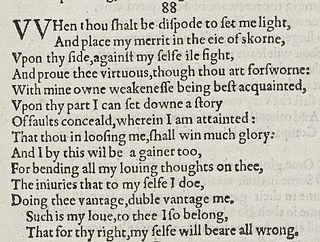
Sonnet 27 is one of 154 sonnets published by William Shakespeare in a quarto titled Shakespeare's Sonnets in 1609. It is a part of the Fair Youth group of sonnets, and the first in a group of five sonnets that portray the poet in solitude and meditating from a distance on the young man. A theme of the first two of the group regards the night and restlessness, which is a motif also found in the sonnets of Petrarch.

Sonnet 28 is one of 154 sonnets published by the English playwright and poet William Shakespeare in 1609. It is a part of what is considered the Fair Youth group, and part of another group that focuses on the solitary poet reflecting on his friend. There is a theme of night and sleeplessness, which is a traditional motif that also occurs in Petrarchan sonnets.

Sonnet 39 is one of 154 sonnets written by the English playwright and poet William Shakespeare. It is a member of the Fair Youth sequence, in which the poet expresses his love towards a young man.

Sonnet 63 is one of 154 sonnets published in 1609 by the English playwright and poet William Shakespeare. It is one of the Fair Youth sequence. Contrary to most of the other poems in the Fair Youth sequence, in Sonnets 63 to 68 there is no explicit addressee, and the second person pronoun is not used anywhere in sonnets 63 to 68.

Sonnet 74 is one of 154 sonnets published by the English playwright and poet William Shakespeare in 1609. It is one of the Fair Youth sequence.

Sonnet 76 is one of 154 sonnets published by the English playwright and poet William Shakespeare in 1609. It's a member of the Fair Youth sequence.

Sonnet 119 is one of 154 sonnets written by the English playwright and poet William Shakespeare. It's a member of the Fair Youth sequence, in which the poet expresses his love towards a young man.

Sonnet 79 is one of 154 sonnets published by the English playwright and poet William Shakespeare in 1609. It is part of the Fair Youth sequence, and the second sonnet of the Rival Poet sequence.

Sonnet 80 is one of 154 sonnets published by the English playwright and poet William Shakespeare in 1609. It is part of the Fair Youth sequence, and the third sonnet of the Rival Poet sequence.

Sonnet 88 is one of 154 sonnets published in 1609 by the English playwright and poet William Shakespeare. It's one of the Fair Youth sequence.

Sonnet 81 is one of 154 sonnets written by William Shakespeare, and published in a quarto titled Shakespeare's Sonnets in 1609. It is a part of the Fair Youth series of sonnets, and the fourth sonnet of the Rival Poet series.

Sonnet 82 is one of 154 sonnets published by William Shakespeare in a quarto titled Shakespeare's Sonnets in 1609. It is a part of the Fair Youth series of sonnets, and the fifth sonnet of the Rival Poet group.

Sonnet 83 is one of 154 sonnets published by William Shakespeare in a quarto titled Shakespeare's Sonnets in 1609. It is a part of the Fair Youth group of sonnets, and the sixth sonnet of the Rival Poet group.

Sonnet 85 is one of 154 sonnets published by the English playwright and poet William Shakespeare in 1609. It's part of the Fair Youth sequence, and the eighth sonnet of the Rival Poet group.

Sonnet 86 is one of 154 sonnets first published by the English playwright and poet William Shakespeare in the Quarto of 1609. It is the final poem of the Rival Poet group of the Fair Youth sonnets in which Shakespeare writes about an unnamed young man and a rival poet competing for the youth's favor. Though the exact date of its composition is unknown, it has been suggested that the Rival Poet series may have been written between 1598 and 1600.

Sonnet 95 is one of 154 sonnets written by the English playwright and poet William Shakespeare. It is a member of the Fair Youth sequence, in which the poet expresses his love towards a young man.

Sonnet 96 is one of 154 sonnets written by the English playwright and poet William Shakespeare. It is a member of the Fair Youth sequence.

Sonnet 111 is one of 154 sonnets written by the English playwright and poet William Shakespeare. It is a member of the Fair Youth sequence, in which the poet expresses his love towards a young man.

Sonnet 114 is one of 154 sonnets written by the English playwright and poet William Shakespeare. It is a member of the Fair Youth sequence, in which the poet expresses his love towards a young man.
Sonnet 120 is one of 154 sonnets written by the English playwright and poet William Shakespeare. It's a member of the Fair Youth sequence, in which the poet expresses his love towards a young man.





















